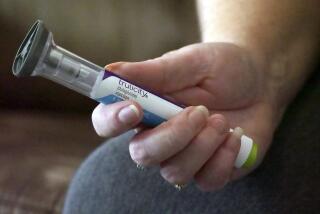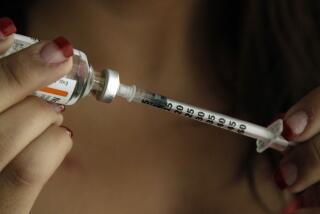A World of Advice for the Peripatetic Diabetic : The condition need not be a hindrance, even in the Third World, if you are properly prepared.
- Share via
June Biermann was admiring a Buddhist temple in Sri Lanka when a priest emerged. “I don’t know how I got started (telling him) that I was diabetic,” Biermann recalled recently. But suddenly he hurried off and came back with his medicine, explaining that he, too, was diabetic.
The story is one of Biermann’s favorites because it reflects her belief that diabetes should not hinder travel and can sometimes work to a traveler’s advantage. With proper planning and a doctor’s blessing, experts contend, travelers with diabetes can tread anywhere. But just as important as being in ideal physical condition is to prepare mentally, said Maury Rosenbaum, publisher of The Diabetic Traveler newsletter, who learned he had diabetes in 1976 and has since traveled the globe.
“What you do before you leave is what makes a major difference in whether the trip is going to be a success or failure,” said Biermann, a Van Nuys writer who, along with Barbara Toohey, has co-authored nine books on diabetes.
On the pre-trip list: Ask your doctor for names of physicians who specialize in diabetes at your destination, said Dr. Sherman Holvey, UCLA clinical professor of medicine, director of the Diabetes Management and Research Center at Century City Hospital and former president of the American Diabetes Assn. An identification card or bracelet is also a good idea to alert people that you have diabetes, Holvey said.
Obtain a letter from your doctor stating that you have diabetes, noting the need for syringes, if they are necessary, the American Diabetes Assn. recommends.
Order a special meal from the airline ahead of time. Read up on a country’s cuisine so you’ll be familiar with typical menu ingredients and which entrees you can handle, Biermann said.
Don’t plan to pick up extra insulin and syringes once you arrive, experts warn. Pack all insulin and syringes, or oral medication, and blood- and urine-testing materials that will be necessary for the length of your trip. And carry an emergency snack of crackers, cheese, fruit or hard candy, the ADA suggests, especially if you have insulin-dependent diabetes.
Take along medicine to treat nausea and vomiting, Holvey said. “It might be useful to have an antibiotic, prescribed by your physician and used only if there is an inability to seek medical attention.” If you are prone to gastrointestinal problems, urinary tract problems or sore throats, for example, ask your doctor if you should pack just-in-case medicines.
Learning a few phrases in the language of your destination can’t hurt, especially in a medical emergency, Biermann and Toohey said. Among handy phrases to master: “Can you tell me which dishes are low in sugar?” “I am a diabetic.” “Call a doctor, please.”
Adjusting your insulin schedule may be necessary during long-distance travel, particularly on flights in which time zones are crossed. Travelers need to discuss the dosage schedule with their physicians. “Each person has their own individual diabetes profile,” Holvey said. “I would recommend that each person, prior to travel, discuss with their physician what recommendations they make regarding insulin based on the blood sugar profile.”
Since insulin needs to stay cool to remain effective, Holvey said, when taking a long car trip, don’t put it in the trunk or other places where it will be exposed to heat.
Stop and get out to walk around occasionally, he suggested. “It’s important if people are sitting for extended periods of time to know that their insulin need may increase as a result of being sedentary,” Holvey said. Monitoring blood sugar values before meals and bedtime could be helpful, he added.
Vacations and other trips are no excuse for a lapse of control of blood sugar levels generally recommended for diabetics, said Dr. Francine Kaufman, USC associate professor of pediatrics and attending physician at Childrens Hospital Los Angeles. “We have all learned that the best way to manage diabetes at any time is to have constant surveillance of the blood sugar, and that is absolutely critical during traveling,” she said. Mention to a flight attendant that you have diabetes, particularly on long flights, Kaufman suggested, and measure blood sugar levels more often than you would at home. Once settled on the plane, for example, it’s a good time to check.
Once home from a long trip, allow yourself a few days of rest if possible, the ADA suggests, before resuming your full-speed routine.
Other recommendations:
* A foreign language phrase card is available in several languages from Biermann and Toohey at Prana Publications, (800) 735-7726.
* A new telephone information line, (800) 847-7226, sponsored by the American Diabetes Assn. and a glucose monitor manufacturer, is staffed with information specialists to answer questions on diabetes, Monday through Friday, 10 a.m.-4 p.m. Pacific Time.
* The Diabetic Traveler newsletter is published quarterly to encourage diabetics to live and travel as normally as possible. A one-year subscription to the quarterly newsletter is $18.95 from P.O. Box 8223 RW, Stamford, Conn. 06905. Sample copies are $2.
More to Read
Sign up for The Wild
We’ll help you find the best places to hike, bike and run, as well as the perfect silent spots for meditation and yoga.
You may occasionally receive promotional content from the Los Angeles Times.






